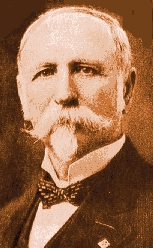
Sheriff Joseph Shipp
Only once in its history has the United States Supreme Court conducted a criminal trial. The trial, taking place in both Tennessee and the District of Columbia in 1907 and 1908, resulted in the conviction of a sheriff, a deputy sheriff, and four members of a Chattanooga lynch mob. Outraged justices ordered the trial on criminal contempt charges after an almost certainly innocent black man, having been convicted of raping a white woman, was lynched less than a day after word reached Chattanooga that his scheduled execution had been stayed by the U. S. Supreme Court.
The trial of Joseph F. Shipp et al. is a story of tragedy and heroism that had been all but forgotten until Mark Curriden, a Dallas reporter, and Leroy Phillips, Jr., a Chattanooga attorney, published their 1999 book, Contempt of Court: The Turn-of-the-Century Lynching that Launched a Hundred Years of Federalism.
INVESTIGATION OF THE RAPE OF NEVADA TAYLOR

St. Elmo Street Station
The Shipp trial has its roots in a rape that took place on a dark January evening in 1906 in the St. Elmo district of Chattanooga. A blond and beautiful twenty-one-year old named Nevada Taylor left her bookkeeping job in downtown Chattanooga about 6:00 p. m. on Monday, January 23. Because it was January, darkness came early. She boarded an electric trolley for the twenty-minute ride to Cemetery Station near the base of Lookout Mountain. Stepping off the trolley at the station near 35th street, Taylor began the short two-and-a-half block walk to her home, a cottage in Forest Hills Cemetery where her father was the groundskeeper. As she approached the cemetery gate, she felt her throat grabbed from behind and a voice say, "If you scream, I will kill you." The attack--which left Taylor unconscious--lasted only ten minutes.
Taylor regained consciousness, walked the one hundred yards to her home, and told her father of the attack. Taylor's father called Sheriff Shipp, who gathered bloodhounds and deputies, then rushed off in a horse-drawn carriage to Taylor's home. As Shipp consoled William Taylor, a doctor arrived to examined his daughter. After completing his investigation, the doctor reported the heartbreaking news: Nevada had been raped.
Shipp asked Taylor what she could remember of the attack. She couldn't recall much, but told the Sheriff he was a little below average height, had muscular arms, and wore a black outfit and a hat, and had "a soft, kind voice." Shipp asked, "Was the man white or Negro?" Taylor answered that she wasn't sure--she hadn't gotten a good look at him--, then said she thought he was black.
The pressure to make an arrest was intense. Shipp publicly announced an award of $50 for information leading to the arrest and conviction of Taylor's attacker. Taylor's employer added $50 more, then the Governor put up another $200. With additional contributions from St. Elmo area residents the reward pot grew to $375--a very substantial sum in 1906.
It took three days for Shipp to make an arrest. An investigation of the crime scene shortly after the rape turned up a black leather strap that perfectly matched red streaks around Taylor's neck. On Thursday, Will Hixson, a man who worked at a medicine company near the cemetery reported that he had seen a black man "twirling a leather strap around his finger" shortly before 6 p.m. on the evening of the rape. Hixson called Shipp later to say that he had just seen that same black man walking north toward town with a tall black man. Finding the tall black man alone, Shipp learned that his companion--and now prime suspect--was a drifter and sometimes carpenter named Ed Johnson. Within hours, Shipp spotted Johnson riding on the back of an ice wagon. Johnson was handcuffed, brought to jail, and identified by Hixson as the man he had seen with the strap by St. Elmo station. Hixon collected his $375 reward.
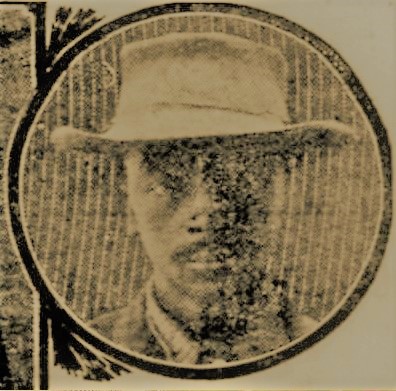
Ed Johnson (Fort Worth Star Telegram photo)
Word of Johnson's arrest spread quickly. That evening a large crowd--many carrying guns--gathered in front of the Hamilton County Jail. Bullets were fired into the sky. Nevada Taylor's younger brother adds fuel to the fire in a brief speech he delivers to the mob: "The time for justice and punishment has come. We want the Negro. He must be punished for what he did to my sister." Soon one member of the mob stepped forward to tell Captain George Brown, second in command at the jail, that he would allow five minutes for someone to turn over the keys or he would lead a violent assault on the jail. No keys were delivered. Leaders of the mob grabbed a steel post and began ramming it against the front door. Others in the mob took over the electric plant, throwing the jail into darkness. Men stole sledgehammers from a nearby blacksmith shop and started working on hinges of the heavy door.
The jail sustained heavy damage from the attack, but there was to be no lynching of Ed Johnson--at least not yet. Deputies and members of Troop B of the National Guard--ordered to the scene by Governor Cox--arrived at the jail. A group of deputies succeeded in grabbing away the sledgehammers. Minutes later, Judge Samuel McReynolds showed up. "The jury is in, Judge, we find him guilty and sentence him to hang by the neck until dead," one man in the crowd announces. McReynolds replied, "Go home." Then the judge told the crowd that the man they were looking for was not in the jail, that he had been sent to Knoxville a few hours earlier. (In fact, Johnson had been sent to Nashville.) McReynolds offered to let five men from the disbelieving crowd inspect the jail: "See for yourself he is not there." After a cell-by-cell search, the five chosen men told the crowd that the judge was right: Johnson was gone.
Nevada Taylor traveled to Nashville the next day and identified--though none too certainly--Johnson as her attacker. That same day, Judge McReynolds convened a grand jury. McReynolds told the grand jurors that "Such outrages as this must have the immediate attention of the law." The Johnson case was on a fast track. Hamilton County District Attorney Matt Whitaker persuaded the grand jury to return an indictment in less than two hours. The next morning, Judge McReynolds appointed three local attorneys to represent Johnson in his upcoming trial: Lewis Shepperd (Chattanooga's most prominent defense attorney), W. G. M. Thomas, and Robert Cameron. McReynolds told the lawyers that the Johnson trial could begin in less than a week. For many in Chattanooga, even that was too long to wait. Some vented their frustrations by threatening Johnson's lawyers. W. G. M. Thomas awoke one evening to the sound of rocks crashing through his windows.
ED JOHNSON TRIAL AND APPEALS
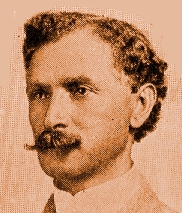
Defense attorney Noah Parden
The Johnson trial opened on Tuesday, February 6. The first prosecution witness was Nevada Taylor. Taylor described the attack, telling jurors how she was pulled behind a fence and assaulted. She identified the leather strap used by her assailant. Prosecutor Whitaker then asked Taylor if the man who attacked her was present in the courtroom. "I believe he is the man," said Taylor, pointing to Ed Johnson. After testimony was given by the doctor who examined Taylor, Whitaker called Will Hixson to the stand. Hixon told jurors that he "saw the defendant with a strap in his hand...near the scene of the crime." Hixson claimed Johnson's face was illuminated by two electric cars passing Cemetery Station: "I saw his face well and could not be mistaken in it." Sheriff Shipp testified next, recounting his investigation and the events leading to Johnson's arrest. Shipp testified that at the sheriff's office in Nashville, Johnson "raised his voice to a higher pitch" in attempt to prevent Taylor from identifying him as the attacker. Two of Shipp's deputies were called for brief testimony, then Whitaker announced, "The state rests."
The first witness for the defense was Ed Johnson. Speaking in "a strange voice," grasping the arms of the witness chair with his hands, Johnson strongly denied having attacked Nevada Taylor. Johnson said he spent the evening of January 23 working as a pool room porter at the Last Chance Saloon, arriving around 4:30 and staying until about 10:00. Thirteen witnesses followed Johnson to the stand, each swearing that he had seen Johnson at the Last Chance around the time he was allegedly in a cemetery raping Nevada Taylor. Then the defense moved on to an attack on the credibility of Will Hixson. Harvey McConnell, described by papers as a respected "old-time Negro," testified that two days after the rape, Hixson had came to the coalyard where he worked and asked him about a black man doing some roofing work at a church in St. Elmo. McConnell said Hixson asked him the man's name. When McConnell told him the man was Ed Johnson, Hixson asked him for a physical description of Johnson. Lewis Shepherd then called his co-counsel, W. G. M. Thomas, to the stand to recount a meeting he arranged between Hixson and McConnell. According to Thomas, when McConnell "repeated the same story we heard here today" to Hixson, Hixson "hung his head very low" and uttered no word of denial.
The most dramatic event of the Johnson trial occurred on its third and last day. At the request of jurors, Nevada Taylor was recalled to the stand. Juror J. L. Wrenn stood and asked Taylor, "Miss Taylor, can you state positively that this Negro is the one who assaulted you?" Taylor answered, "I will not swear he is the man, but I believe he is the Negro who assaulted me." Wrenn, still not satisfied, asked again: "In God's name, Miss Taylor, tell us positively--is that the guilty Negro? Can you say it? Can you swear it?" With tears streaming down her face and in a quivering voice, Taylor replied, "Listen to me. I would not take the life of an innocent man. But before God, I believe this is the guilty Negro." At that point another juror rose and lunged in the direction of Johnson. As he was restrained by fellow jurors, he shouted out, "If I could get at him, I'd tear his heart out right now."
The jury deliberated the fate of Ed Johnson for over six hours. The jury was split: eight favoring conviction and four favoring acquittal. After a night home with their families, the minority suddenly gave in. At 9:25 a.m. the next morning, the jury's foreman announced, "On the single count of rape, we, the jury, find the defendant, Ed Johnson, guilty." Then, after a recess, came a surprising announcement from defense attorney W. G. M. Thomas: the defense would "acquiesce in the action of the jury."
Johnson's defense attorneys had split two to one against appealing his conviction. Thomas and Cameron concluded that an appeal would be futile and invite a raid on the jail that might not only result in Johnson's death, but those of other inmates as well. Shepherd, the only experienced criminal lawyer of the three, disagreed, but was outvoted. Thomas told Johnson his choice was to accept the verdict and die in an orderly way at an appointed time or to die at the hands of a lynch mob. Johnson reportedly told Thomas, "I will tell the judge I am ready to die. But I will also say that I am not the guilty man." Judge McReynolds sentenced Johnson to be "hung by the neck until dead" on March 13, 1906.
Hours after Johnson heard his sentence pronounced, Ed's father (known as "Skinbone" Johnson) visited the law office of Chattanooga's most highly respected African Attorney, Noah Parden. Skinbone Johnson told Parden that his son did not want to die. He wanted to appeal. Parden was reluctant to take the case. Although Johnson may well have been innocent and denied a fair trial, convincing the Tennessee Supreme Court to grant a new trial in an emotionally charged case such as this would be next to impossible. Parden's law partner, Styles Hutchins, thought differently, however. It was a lawyer's job to do justice, he argued. They decided to take the case. Sunday morning, Parden paid a visit to the home of Lewis Shepherd and recruited him to continue the fight for justice for Ed Johnson.
On Monday, February 12, Parden and Hutchins visited Judge McReynolds in his courtroom to inform him of their intention to appeal Ed Johnson's conviction. They told them that they had a motion ready. McReynolds, stunned by this development and fearing the consequences of a delay in Johnson's execution, told the two attorneys to return the next day to formally file their motion. Return the next day Parden and Hutchins did, only to be told by the judge that they were one day late: the time limit for filing a motion for a new trial was three days--this was the fourth. Parden and Hutchins left the courtroom feeling they had been tricked.
As Parden and Hutchins prepared an appeal to the Tennessee Supreme Court, they began to understand what they were up against. No one, it seemed, wanted to employ lawyers who had stirred up the anger of a judge and the white legal establishment. Moreover, officials did what they could to complicate their efforts. Officials at the court claimed to have difficulty in locating the case file. The court stenographer, for the first time, insisted that money for the trial transcript be paid in full before delivery.
On March 3, 1906, the Tennessee Supreme Court, without a dissenting vote, turned down Johnson's request for a new trial. Writing for the Court, Chief Justice W. D. Beard wrote, "We have given the technical record a most scrutinizing inspection to see if serious errors were there to be discovered, but have been unable to find any." Sheriff Shipp ordered his deputies to began stretching the inch thick rope that would be used to hang Johnson on March 13.
But Noah Parden had not given up. He would take the battle to save Ed Johnson to the federal courts. On March 7, Parden took the train to Knoxville to file a petition for a writ of habeas corpus in federal district court. District Judge Charles Clark set March 10th as the date for a hearing on the petition.
In 1906, there was little reason to expect relief in the federal courts. Federal judges could not reconsider the evidence presented in state trials. They could only act when the federal constitutional rights of the defendant had been violated. Moreover, the Supreme Court had narrowly interpreted the Fourteenth Amendment's due process clause. The protections of the Bill of Rights--to an impartial jury, to effective counsel, right against self-incrimination, and all of its other guarantees--had not yet been found by the Court to be applicable in state trials. As of 1906, there existed not one case in which the federal courts had reversed a state court conviction on the basis of the due process clause. (One conviction, in 1886, was reversed on an equal protection claim.)
Parden argued before Judge Clark that Johnson's trial was riddled with constitutional violations. He contended that Judge McReynold's refusal to delay or move the trial--in view of the attempted lynching and other threats--was a denial of due process. He said the same thing about the juror's "tear his heart out" lunge at Johnson. He argued that Hamilton County's systematic exclusion of black jurors violated the equal protection clause. Finally, Parden suggested that Johnson had been abandoned by his court appointed attorneys after trial. "Like a lamb being led to the slaughter, he was dumb," Parden said. Witnesses were called to substantiate the various defense claims. W. G. M. Thomas was called to testify that he based his decision not to appeal on reports that more than two dozen men had said an appeal would lead to a lynching: "It was said a dilatory movement would wind up lynching the judge, lawyers, and everyone else."
After listening to arguments and witnesses on both sides for eight hours, Judge Clark announced that he would issue his decision later that evening. Shortly before 1:00 a.m., the judge returned to his courtroom. Judge Clark agreed that there might have been serious flaws in Johnson's trial, but he ruled that the Sixth Amendment's guarantee of a fair trial did not apply in state court trials. He rejected Johnson's equal protection claim, as well. In a small victory for the defense, however, Clark postponed Johnson's hanging for ten days (later reduced, in a concession to angered state officials, to seven days) to allow time for his decision to be appealed to the United States Supreme Court.
In the early morning hours of March 15, an unidentified person sets fire to the wood frame law office of Parden and Hutchins. The blaze is extinguished without major damage. Later that afternoon, Parden left Chattanooga by train for Washington, where he will make his final plea to save Ed Johnson's life.
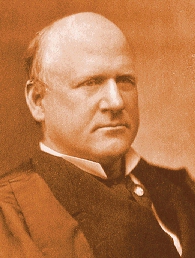
Justice John Harlan
On the morning of March 17, Parden and a Washington lawyer named Emanuel Hewlett entered the waiting room of the Supreme Court in the Old Senate Chamber. The wait seemed interminable. Parden began to despair:
As the day expired, I prepared my soul for failure. Then I convinced myself this effort required nothing short of a miracle. It was late in the evening and I had all but given up. I folded my hands and asked God for guidance on how to tell Ed Johnson's family that I had failed.
Finally the Court's receptionist stood in the doorway and announced, "He will see you now." The "he" turned out to be Justice John Marshall Harlan, the same justice who--observing that "The Constitution is colorblind"--dissented in Plessy vs Ferguson, the famous case which upheld the principle of "separate but equal." Harlan asked Johnson's lawyers, "Mr. Parden, Mr. Hewlett, tell me why the United States Supreme Court should care about this case?" The two lawyers proceeded to do so. The elderly justice nodded without giving them a word of encouragement.
With his client's scheduled execution less than two days away, Noah Parden arrived back at the Chattanooga train station to see his obviously overjoyed partner, Styles Hutchins, waving a piece of paper in the air. It was a telegram from Washington to signed by Justice John Harlan: "Have allowed appeal to accused in habeas corpus case of Ed Johnson." In the hours after his meeting with Parden, Harlan had read the transcript of the Knoxville hearing and became convinced Johnson's case raised serious constitutional issues. At Harlan's request, a majority of justices gathered on Sunday morning at the home of Chief Justice Fuller to his plea for intervention. After debating the issue for an hour, the justices agreed upon their unprecedented action of staying the execution and granting Johnson's appeal. Harlan ordered telegrams sent to District Judge Clark, the defense lawyers, Judge McReynolds, District Attorney McReynolds, and Sheriff Shipp informing them of the Supreme Court's action.
THE LYNCHING OF ED JOHNSON
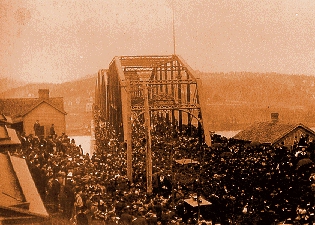
Walnut Street Bridge, scene of the lynching
The news that the Supreme Court had stayed Johnson's scheduled execution did not sit well with many in Chattanooga. About 8 p.m. on March 19 a group of men carrying guns descended on the Hamilton County Jail where Johnson was being held. Only a single guard, jailer Jeremiah Gibson, guarded the prisoners. Sheriff Shipp, rejecting a suggestion to post extra guards, had instead given his other deputies the night off. In the days after Johnson's arrest, six to ten deputies with guns guarded the county jail, but on March 19, the job fell to just one deputy.
The first members of the mob to enter the jail bloodied a black trusty they encountered, then began their search of the jail. More and more men poured into the jail. Confronting a large steel door, members of the mob called for a sledgehammer and began whacking it in turns. The door finally gave into the attack and the mob moved on to its next obstacle. About 8:30 p.m., Ed Johnson, on the third floor, was awakened by the cries of inmates below. Johnson looked out the window of his cell to see the crowd of nearly two hundred men and women in the courtyard below. The only other inmate on the floor, Ellen Baker, said to Johnson, "You better do some prayin'." Soon the mob made their way up the spiral staircase to the third floor and began pounding on the doors that still separated them from Johnson.
A second door comprised of steel bars secured by five bolts riveted into the cement floor proved a frustrating obstacle for the rioters. Johnson had plenty of time to pray. Ellen Baker later described Johnson lying on his steel-framed bunk, a green wool blanket pulled up to his chin, eyes closed, reciting the 23rd Psalm. It was not until 10:35 that the last bolt gave way and the men made their way to Johnson's cell. A key taken from Gibson opened the cell door. The men tied Johnson's hands with rope and dragged him from the cell out to an awaiting crowd.
Cries of "Kill him now!" and "Cut his heart out right here!" came from the mob. The leaders of the mob debated what they should do. Finally someone yelled, "To the county bridge!" The call was met by great applause. For six blocks, in raucous procession, the crowd marched to the Walnut Street Bridge that spanned the Tennessee River. At the second span rope was looped around the frame of the bridge. "Do you have anything to say?" a man holding a noose asked Johnson. With the noose around his neck and blood dripping from his mouth, Johnson remained calm. He spoke to the crowd:
I am ready to die. But I never done it. I am going to tell the truth. I am not guilty. I have said all the time that I did not do it and it is true. I was not there.
I know I am going to die and I have no fear to die and I have no fear at all.
I was not at St. Elmo that night. Nobody saw me with a strap. They were mistaken and saw somebody else. I was at the Last Chance Saloon just as I said.
I am not guilty and that is all I have to say.
God bless you all. I am innocent.
For two minutes, Ed Johnson's body "jerked with life" as it swayed one hundred feet above the Tennessee River, then it stopped. Johnson was pulled back up to the bridge. His head moved. A barrage of bullets ended his life. A leader of the mob pinned a sheet of paper to Johnson's body. The note read: "To Justice Harlan. Come and get your nigger now."
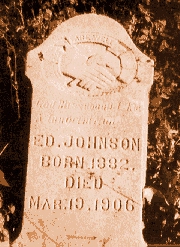
Tombstone of Ed Johnson
The next morning, word of Johnson's lynching reached Washington. Although in recess, Justice Harlan and Justice Oliver Wendell Holmes met with Chief Justice Fuller. After a closed-door meeting, each justice expressed his outrage to the press. Justice Harlan told a reporter for the Washington Post, "[Johnson] had the right to a fair trial, and the mandate of the Supreme Court has for the first time in the history of the country been openly defied by a community." Holmes was no less angry: "In all likelihood, this was a case of an innocent man improperly branded a guilty brute and condemned to die from the start." President Theodore Roosevelt announced, "It is an affront to the highest tribunal in the land that cannot go by without the proper action being taken."
In Chattanooga, the reaction to the lynching was decidedly mixed. Dr. Howard Jones, minister of the city's establishment First Baptist Church, condemned the killing of Ed Johnson in the strongest possible terms. "Lawlessness begets lawlessness," he told his all-white congregation. On the other hand, J. G. Rice, editorialized in his Chattanooga News that "the worthless, shiftless, criminal black brute who outrages a white woman has no more rights under the law than a serpent."
President Roosevelt met with Attorney General William Moody to consider the response of the federal government to the lynching. Roosevelt decided to order a federal preliminary investigation which, it was understood, might be used by the Supreme Court should it choose to bring criminal contempt charges. Less than two days after the lynching, two Secret Service agents--E. P. McAdams and Henry G. Dickey--were on their way to Chattanooga to began collecting evidence.
The agents soon discovered that on the matter of Johnson's lynching most lips in Tennessee were firmly sealed. Walking back to their hotel after an unproductive day of investigating, McAdams and Dickey were warned to leave town and then assaulted by three pipe-wielding men. The agents were undeterred. Eventually, they with the assistance of people such Reverend Jones and Noah Parden, the agents were led to witnesses who began to shed some light on the events surrounding the lynching. (Dr. Jones paid a price for his cooperation: the night after he talked with federal agents, Jones returned to find his home ablaze.)
On April 20, Dickey and McAdams filed their report on the lynching. The report detailed unusual activities at the jail prior to the lynching, including the failure to protect the jail with additional deputies and the moving of all but one inmate from the floor occupied by Johnson. It indicated that both Judge McReynolds and District Attorney Whitaker knew about the attack on the jail from the moment it began and watched events unfold from their courtroom window. The agents noted that Sheriff Shipp did nothing to stop the lynching and--despite spending an hour near the mob leaders--claimed, implausibly, not to be able to identify a single conspirator.
TRIAL IN THE SUPREME COURT OF THE UNITED STATES
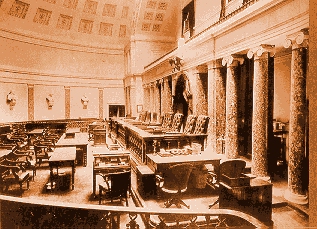
The Old Senate Chamber, site of Shipp trial
A month later, Attorney General Moody met with Chief Justice Fuller and Justice Harlan. An hour of debate produced an historic agreement: the Chattanooga conspirators would be tried by the Court for criminal contempt. It would be the first--and, to date, the only--criminal trial in the history of the United States Supreme Court. The Attorney General agreed to file charges with the clerk of the Supreme Court. The Justice Department, rather than the Court (as was at one time discussed), would lead the prosecution.
On May 28, 1906, the Justice Department filed papers accusing twenty-seven Chattanooga residents of conspiring to lynch and murder Ed Johnson. Named in the papers were Sheriff Joseph Shipp and eight of his deputies.
The defendants and their lawyers assembled in the courtroom on the second floor of the Capitol Building on October 15, 1906. After the justices of the Supreme Court took their seats on the bench, Solicitor General Henry Hoyt announced that the federal government was ready to proceed with the case of United States v. Shipp. Noah Parden and Styles Hutchins watched from front-row seats as lawyers for the accused stepped forward to enter their pleas of "Not Guilty."
Before the Court would allow evidence to be taken in the Shipp case, it needed to resolve the troublesome question of jurisdiction: Did the Court have the power to try Shipp and the others for criminal contempt? The Supreme Court heard oral arguments on the jurisdictional issue on December 4. Noah Parden and Joseph Shipp sat directly across the aisle from each other as they listened to lawyers for both sides present their cases. Solicitor General Henry Hoyt argued that the Court did have jurisdiction. Hoyt contended that Johnson's right to be heard on his application for habeas corpus was protected by the Constitution and that the Court acted appropriately in staying his execution. "This proceeding is about nothing less than establishing and protecting the rule of law," Hoyt told the justices. Judson Harmon, a Cincinnati lawyer representing Sheriff Shipp, countered by arguing that none of Johnson's federally protected rights had been violated and that therefore the Court improperly granted its stay. Since the stay was improperly issued, Harmon argued, no one who violated the Court's orders should be found in contempt. Harmon was interrupted by Justice Holmes who asked, "But you would agree that this Court has the authority to determine that the Sixth Amendment [with its guarantee of a fair trial] is binding on the state courts, do you not?" The possibility that the Court might actually be ready to apply the protections of the Bill of Rights to state courts shocked Harmon, and he understood for the first time how strongly incensed some of the justices must have been with the handling of the Johnson case. On Christmas Eve, the Court, in a unanimous decision written by Oliver Wendell Holmes, ruled that it had the jurisdiction to try Shipp and the other accused conspirators.
The Shipp trial opened in the United States Custom House Chattanooga (the Court decided that witnesses could more easily be gathered there than in Washington) on February 12, 1907. Having neither the time nor inclination to travel to Tennessee to hear weeks of testimony, the justices appointed James D. Maher, deputy clerk of the Supreme Court, to preside at the trial and prepare an evidentiary record which they could review. The courtroom was filled to capacity--mostly by African-Americans--as Maher took his seat on the bench.
Assistant Attorney General Terry Sanford presented the prosecution's case. His first witness was J. L. Chivington, a reporter for the Chattanooga Times, who had witnessed and written about Johnson's lynching. Chivington testified that "there were normally six or seven deputies on guard every night" at the jail--except the night of March 19. Edward Chaddick, manager of the Western Union telegram office, testified that he had hand-delivered to Sheriff Shipp a telegram from the United States Supreme Court on the afternoon of the lynching. Ellen Baker provided the most riveting testimony of the trial's first day. Baker testified that all the other third-floor prisoners were removed to lower floors on the afternoon of the lynching, leaving just her and Johnson on the third floor. Baker said that she began crying and shouting as the mob made its way through the jail. Deputy Gibson "told me to hush hollering, there warn't nobody going to hurt me," Baker added. About the same time, a man poked his gun through the bars to her cell: "It scared me--I quit hollering."
A key witness for the prosecution was a John Stonecipher, a Georgia contractor who had talked with some leaders of the mob at a saloon just hours before the lynching. According to Stonecipher, a man named Frank Ward said to him as he stood on a curb waiting for a car to go home, "We want you to help us lynch that damn nigger tonight." Stonecipher replied with the suggestion, "I believe Sheriff Shipp would shoot the red-hot stuff out of you." "No," answered Ward, "it is all agreed. There won't be a sheriff or deputy there." Stonecipher also testified concerning conversations after the lynching with defendants Ward, Henry Padgett, Alf Handman, and William Mayes. According to Stonecipher, Ward complained to him, "You are the first damn man from Georgia ever I saw that didn't have nerve enough to kill a nigger." After offering his testimony, Stonecipher received an anonymous letter from "The Lynchers" threatening to blow up his house with dynamite.
After the government produced thirty-one witnesses over five days, Commissioner Maher then recessed the trial until June. When the trial resumed, Terry Sanford called to the stand a Chattanooga justice of the peace, A. J. Ware. Ware had been told by some black youths that a lynching was taking place. He followed the lynch mob to the Walnut Street Bridge. Asked by Sanford who he saw adjust the noose around Ed Johnson's neck, Ware replied, "Nick Nolan." Sanford asked Ware who shot Johnson after he was pulled back up on the bridge. "I believe it was Luther Williams," Ware answered. "He fired five shots into Johnson's body."
On Saturday, June 15, the defense began to present its case. Friends, relatives, and co-workers took to the stand to offer alibis or attest to the high moral character of various of the defendants. Some of the defendants themselves also testified. Bart Justice said he spent the night of Johnson's lynching at home in bed--and his wife and daughter backed his claim up. Only one defendant, Luther Williams, admitted being present at the lynching. He claimed to have been only a spectator. Other witnesses challenged the credibility of prosecution witnesses. Jailer Jeremiah Gibson denied having told inmate Ellen Baker that he thought a mob would be coming that night.
Sheriff Joseph Shipp was the last witness called by the defense. Shipp testified: "I never conspired with any living man, my deputies or anyone else; and I had no knowledge, not the slightest, that there would be any effort on my part or anybody to interfere with Johnson." Shipp claimed to have "run most of the way and walked rapidly the balance of the way" to the jail as soon as he learned that a lynching was in progress. At the jail, Shipp told the court, "I was seized from behind by several men." They put me in a bathroom and "stood over me with a guard" as the mob leaders continued "the progress of the work." On cross-examination, Shipp claimed not to have recognized any of the mob members at the jail, even though he was held there--without blindfolds--for thirty minutes. Asked why he didn't pull his gun to stop the lynching, Shipp replied, "I had no adequate force, and knew that the pulling of a gun would be useless." An earlier prosecution witness, a minister who urged Shipp at the jail to go down to the bridge to identify the lynchers, said he was told by Shipp that doing that would be "dangerous and foolish.'
On June 29, the defense rested. In March of 1909, the trial moved to the Supreme Court in Washington, where both sides would have the opportunity to present closing arguments. Attorney General Charles Bonaparte told the Court that he believed the issues involved in the Shipp case to be so important that he decided to deliver the final argument himself. In his six-hour summation, Bonaparte reviewed the evidence of the trial and made the case for a guilty verdict. Bonaparte told the justices that "Justice is at an end when orders of the highest and most powerful court in the land are set at naught." Judson Harmon presented the closing argument for Sheriff Shipp the following day. Hudson conceded that his client did not, in retrospect, handle the situation properly: "It is possible that Captain Shipp acted with poor judgment on the night of the lynching. It is easy to see that he should have guarded the jail and prepared for a mob." But certainly, Harmon argued, "Captain Shipp cannot be convicted of contempt by this Court simply because, in the performance of his duties, he exercised bad judgment." He concluded by urging "this highest and greatest court in the world" to find Shipp, this "truthful, law-abiding, honorable gentleman," "Not Guilty." After listening to brief arguments from lawyers for the other defendants, the Court adjourned to consider its verdict.
On Monday, May 24, 1909, the Supreme Court met to announce its decision in the matter of United States v. Shipp. In his quiet voice, Chief Justice Fuller read his opinion. Fuller said that Sheriff Shipp "resented the necessary order of this court as an alien intrusion" and believed it to be "responsible for the lynching." The Court concluded otherwise: "Shipp not only made the work of the mob easy, but in effect aided and abetted it." Shipp was found guilty of criminal contempt. The Court also declared jailer Jeremiah Gibson and four members of the lynch mob--Nick Nolan, William Mayes, Henry Padgett, and Luther Williams guilty. Evidence was found insufficient to convict Deputy Matthew Galloway and two members of the lynch mob. Justices Holmes, Harlan, Brewer, and Day joined Chief Justice Fuller's decision. One justice abstained, while three dissenting justices voted to acquit all defendants.
On November 15, 1909, Sheriff Shipp and the other convicted defendants stood before the nine justices of the Supreme Court to receive their sentences. Justice Fuller announced:
You, Sheriff Joseph F. Shipp, Jeremiah Gibson, Luther Williams, Nick Nolan, Henry Padgett, and William Mayes, are before this court on an attachment for contempt. You have been found guilty.
Sheriff Shipp, Luther Williams, and Nick Nolan are hereby sentenced to ninety days imprisonment. Jeremiah Gibson, Henry Padgett, and William Mayes are hereby sentenced to sixty days. All sentences are to be served at the United States Jail in the District of Columbia.
This Court is adjourned.
Writing in the Atlanta Independent, Noah Parden praised the Court's decision: "The very rule of law upon which this country was founded and on which the future of this nation rests has been enforced with the might of our highest tribunal."
On January 30, 1910, after completing his three-month sentence, Sheriff Shipp returned to Chattanooga, where he received a hero's welcome. As he stepped off the train from Washington, he was greeted by a crowd of more than 10,000 people singing "Dixie."

But times change, even if more slowly in the South than elsewhere. In 2121, the Ed Johnson Memorial, including sculptural representations of Ed Johnson and his attorneys Noah Parden and Styles Hutchins, was dedicated in a location close to the Walnut Street Bridge.
